PG: ITC540 - IT Infrastructure Management Report Analysis
VerifiedAdded on 2020/03/04
|9
|1975
|131
Report
AI Summary
This report provides a comprehensive analysis of IT infrastructure management, addressing key terminologies such as Just-in-Time Delivery, E-Commerce, SaaS, and strategic planning. It explores the key elements of data mining, emphasizing the importance of extracting, transforming, and loading data, along with its storage and presentation. The report further delves into the significance of the "Reserve Stock Level" function in ERP systems and its role in maintaining efficient supply chains. It then examines business risks faced by Liberty Wines and how IT infrastructure impacts its competitive advantage, including the benefits of server virtualization. Additionally, the report discusses IT problems limiting FinCEN's ability to fight financial crime, detailing necessary IT upgrades and the role of data analytics in crime detection, including recent financial crimes and the disruption of illicit financial flows. The report references several sources, including academic journals and publications, to support its findings.
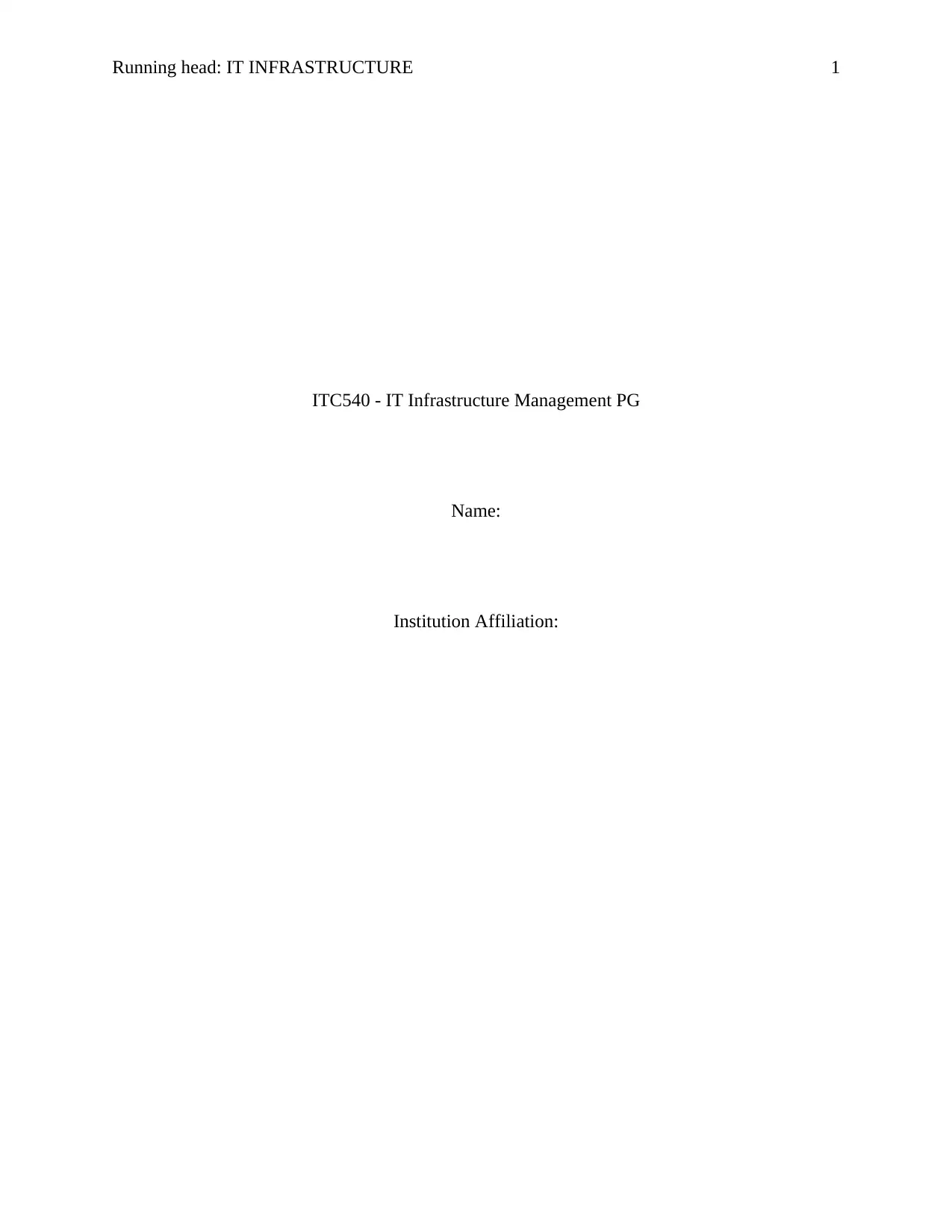
Running head: IT INFRASTRUCTURE 1
ITC540 - IT Infrastructure Management PG
Name:
Institution Affiliation:
ITC540 - IT Infrastructure Management PG
Name:
Institution Affiliation:
Paraphrase This Document
Need a fresh take? Get an instant paraphrase of this document with our AI Paraphraser
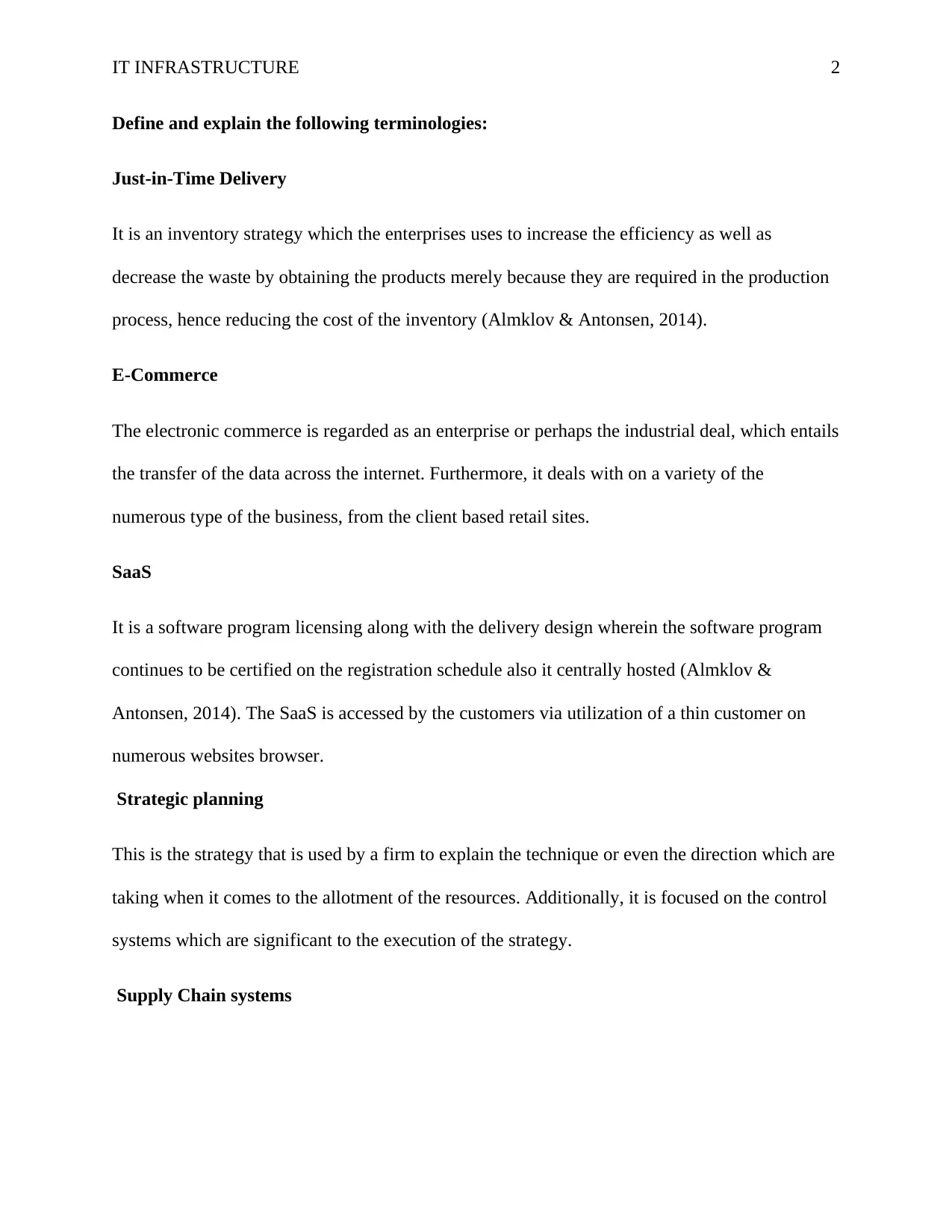
IT INFRASTRUCTURE 2
Define and explain the following terminologies:
Just-in-Time Delivery
It is an inventory strategy which the enterprises uses to increase the efficiency as well as
decrease the waste by obtaining the products merely because they are required in the production
process, hence reducing the cost of the inventory (Almklov & Antonsen, 2014).
E-Commerce
The electronic commerce is regarded as an enterprise or perhaps the industrial deal, which entails
the transfer of the data across the internet. Furthermore, it deals with on a variety of the
numerous type of the business, from the client based retail sites.
SaaS
It is a software program licensing along with the delivery design wherein the software program
continues to be certified on the registration schedule also it centrally hosted (Almklov &
Antonsen, 2014). The SaaS is accessed by the customers via utilization of a thin customer on
numerous websites browser.
Strategic planning
This is the strategy that is used by a firm to explain the technique or even the direction which are
taking when it comes to the allotment of the resources. Additionally, it is focused on the control
systems which are significant to the execution of the strategy.
Supply Chain systems
Define and explain the following terminologies:
Just-in-Time Delivery
It is an inventory strategy which the enterprises uses to increase the efficiency as well as
decrease the waste by obtaining the products merely because they are required in the production
process, hence reducing the cost of the inventory (Almklov & Antonsen, 2014).
E-Commerce
The electronic commerce is regarded as an enterprise or perhaps the industrial deal, which entails
the transfer of the data across the internet. Furthermore, it deals with on a variety of the
numerous type of the business, from the client based retail sites.
SaaS
It is a software program licensing along with the delivery design wherein the software program
continues to be certified on the registration schedule also it centrally hosted (Almklov &
Antonsen, 2014). The SaaS is accessed by the customers via utilization of a thin customer on
numerous websites browser.
Strategic planning
This is the strategy that is used by a firm to explain the technique or even the direction which are
taking when it comes to the allotment of the resources. Additionally, it is focused on the control
systems which are significant to the execution of the strategy.
Supply Chain systems
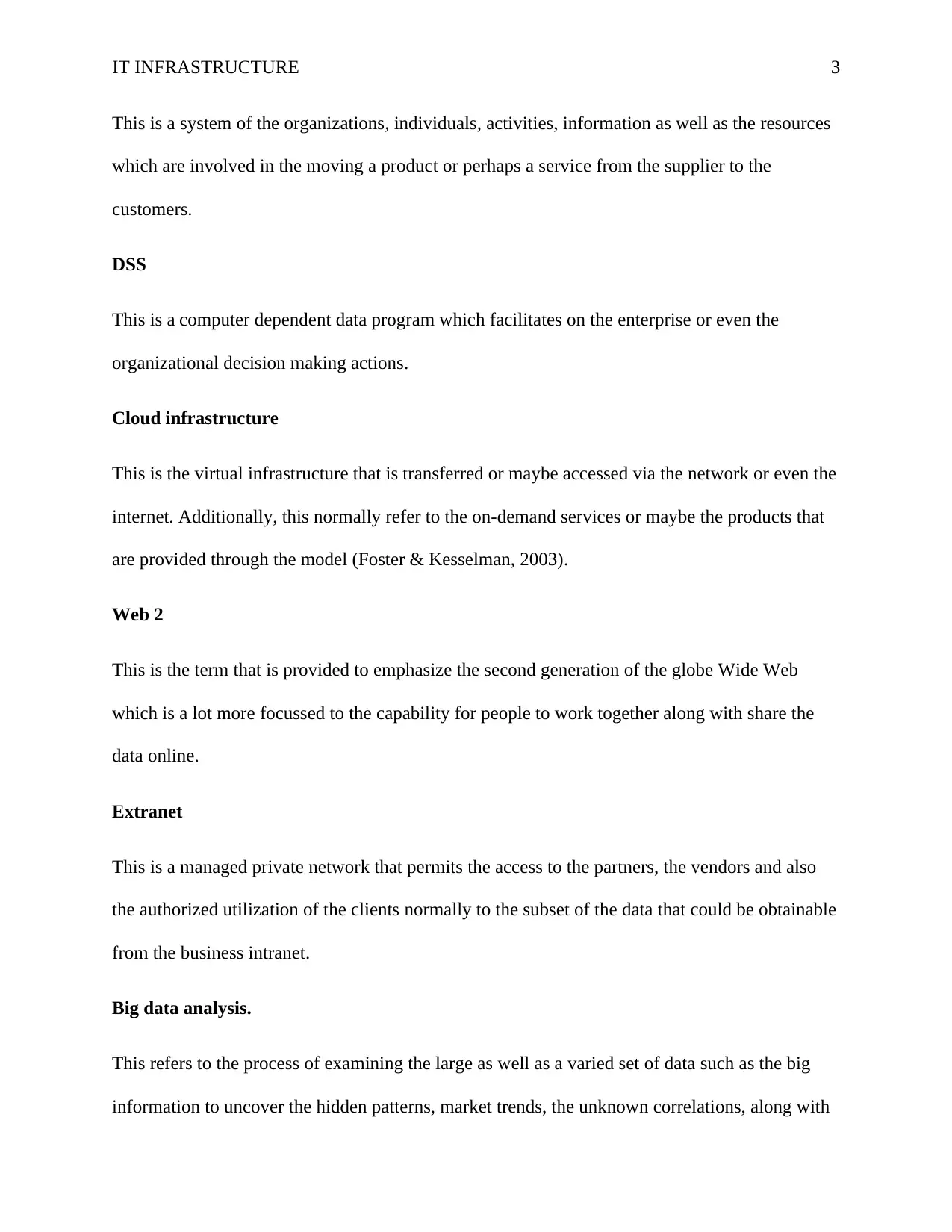
IT INFRASTRUCTURE 3
This is a system of the organizations, individuals, activities, information as well as the resources
which are involved in the moving a product or perhaps a service from the supplier to the
customers.
DSS
This is a computer dependent data program which facilitates on the enterprise or even the
organizational decision making actions.
Cloud infrastructure
This is the virtual infrastructure that is transferred or maybe accessed via the network or even the
internet. Additionally, this normally refer to the on-demand services or maybe the products that
are provided through the model (Foster & Kesselman, 2003).
Web 2
This is the term that is provided to emphasize the second generation of the globe Wide Web
which is a lot more focussed to the capability for people to work together along with share the
data online.
Extranet
This is a managed private network that permits the access to the partners, the vendors and also
the authorized utilization of the clients normally to the subset of the data that could be obtainable
from the business intranet.
Big data analysis.
This refers to the process of examining the large as well as a varied set of data such as the big
information to uncover the hidden patterns, market trends, the unknown correlations, along with
This is a system of the organizations, individuals, activities, information as well as the resources
which are involved in the moving a product or perhaps a service from the supplier to the
customers.
DSS
This is a computer dependent data program which facilitates on the enterprise or even the
organizational decision making actions.
Cloud infrastructure
This is the virtual infrastructure that is transferred or maybe accessed via the network or even the
internet. Additionally, this normally refer to the on-demand services or maybe the products that
are provided through the model (Foster & Kesselman, 2003).
Web 2
This is the term that is provided to emphasize the second generation of the globe Wide Web
which is a lot more focussed to the capability for people to work together along with share the
data online.
Extranet
This is a managed private network that permits the access to the partners, the vendors and also
the authorized utilization of the clients normally to the subset of the data that could be obtainable
from the business intranet.
Big data analysis.
This refers to the process of examining the large as well as a varied set of data such as the big
information to uncover the hidden patterns, market trends, the unknown correlations, along with
⊘ This is a preview!⊘
Do you want full access?
Subscribe today to unlock all pages.

Trusted by 1+ million students worldwide
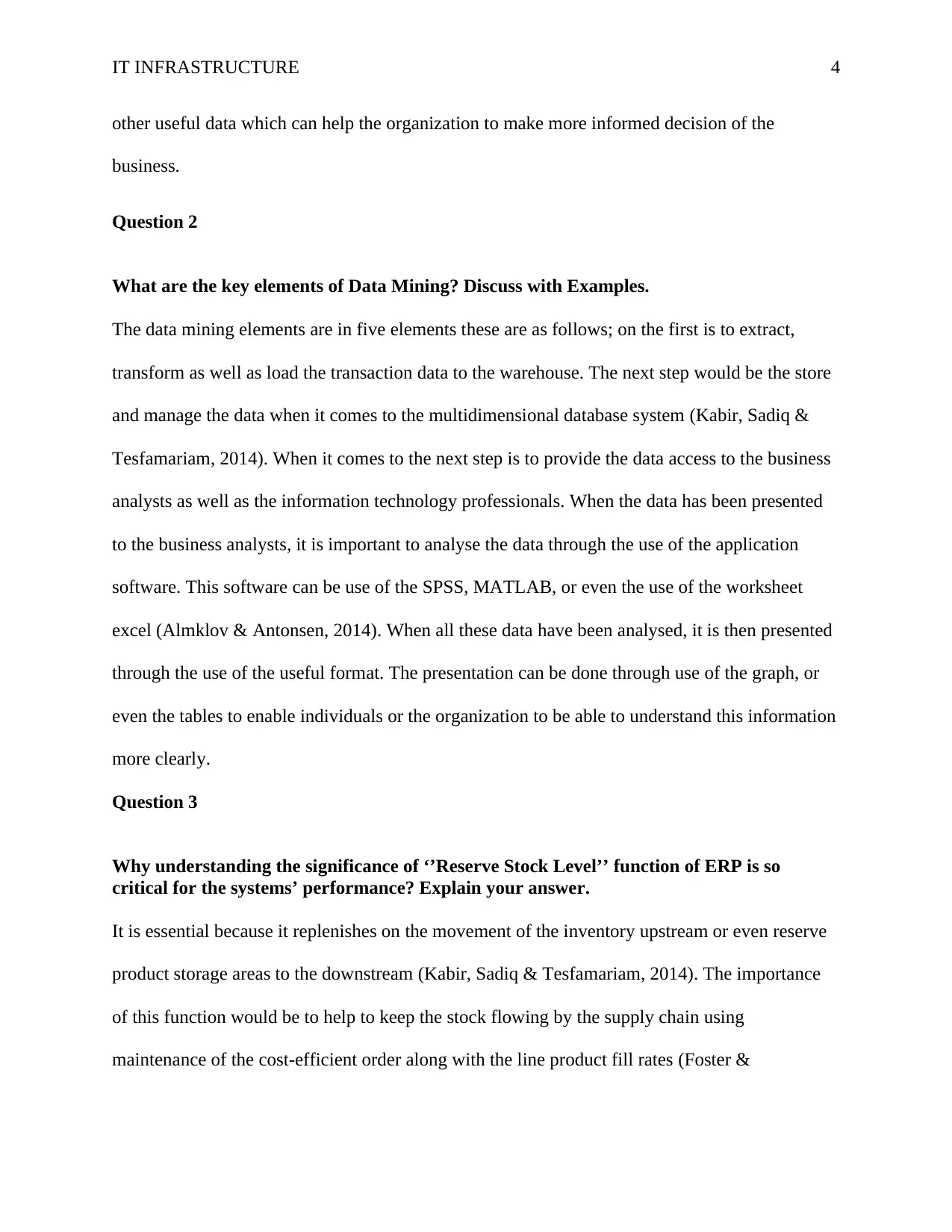
IT INFRASTRUCTURE 4
other useful data which can help the organization to make more informed decision of the
business.
Question 2
What are the key elements of Data Mining? Discuss with Examples.
The data mining elements are in five elements these are as follows; on the first is to extract,
transform as well as load the transaction data to the warehouse. The next step would be the store
and manage the data when it comes to the multidimensional database system (Kabir, Sadiq &
Tesfamariam, 2014). When it comes to the next step is to provide the data access to the business
analysts as well as the information technology professionals. When the data has been presented
to the business analysts, it is important to analyse the data through the use of the application
software. This software can be use of the SPSS, MATLAB, or even the use of the worksheet
excel (Almklov & Antonsen, 2014). When all these data have been analysed, it is then presented
through the use of the useful format. The presentation can be done through use of the graph, or
even the tables to enable individuals or the organization to be able to understand this information
more clearly.
Question 3
Why understanding the significance of ‘’Reserve Stock Level’’ function of ERP is so
critical for the systems’ performance? Explain your answer.
It is essential because it replenishes on the movement of the inventory upstream or even reserve
product storage areas to the downstream (Kabir, Sadiq & Tesfamariam, 2014). The importance
of this function would be to help to keep the stock flowing by the supply chain using
maintenance of the cost-efficient order along with the line product fill rates (Foster &
other useful data which can help the organization to make more informed decision of the
business.
Question 2
What are the key elements of Data Mining? Discuss with Examples.
The data mining elements are in five elements these are as follows; on the first is to extract,
transform as well as load the transaction data to the warehouse. The next step would be the store
and manage the data when it comes to the multidimensional database system (Kabir, Sadiq &
Tesfamariam, 2014). When it comes to the next step is to provide the data access to the business
analysts as well as the information technology professionals. When the data has been presented
to the business analysts, it is important to analyse the data through the use of the application
software. This software can be use of the SPSS, MATLAB, or even the use of the worksheet
excel (Almklov & Antonsen, 2014). When all these data have been analysed, it is then presented
through the use of the useful format. The presentation can be done through use of the graph, or
even the tables to enable individuals or the organization to be able to understand this information
more clearly.
Question 3
Why understanding the significance of ‘’Reserve Stock Level’’ function of ERP is so
critical for the systems’ performance? Explain your answer.
It is essential because it replenishes on the movement of the inventory upstream or even reserve
product storage areas to the downstream (Kabir, Sadiq & Tesfamariam, 2014). The importance
of this function would be to help to keep the stock flowing by the supply chain using
maintenance of the cost-efficient order along with the line product fill rates (Foster &
Paraphrase This Document
Need a fresh take? Get an instant paraphrase of this document with our AI Paraphraser
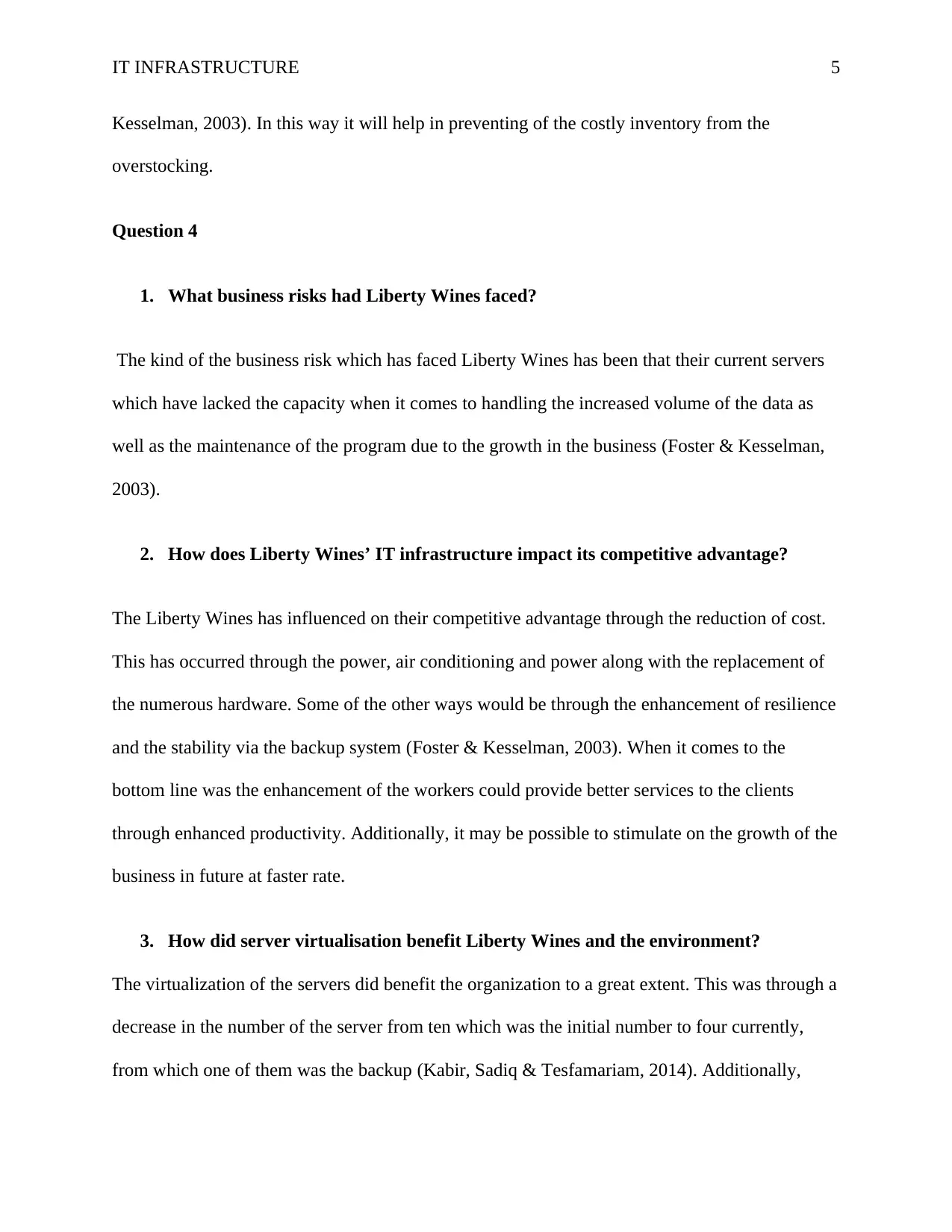
IT INFRASTRUCTURE 5
Kesselman, 2003). In this way it will help in preventing of the costly inventory from the
overstocking.
Question 4
1. What business risks had Liberty Wines faced?
The kind of the business risk which has faced Liberty Wines has been that their current servers
which have lacked the capacity when it comes to handling the increased volume of the data as
well as the maintenance of the program due to the growth in the business (Foster & Kesselman,
2003).
2. How does Liberty Wines’ IT infrastructure impact its competitive advantage?
The Liberty Wines has influenced on their competitive advantage through the reduction of cost.
This has occurred through the power, air conditioning and power along with the replacement of
the numerous hardware. Some of the other ways would be through the enhancement of resilience
and the stability via the backup system (Foster & Kesselman, 2003). When it comes to the
bottom line was the enhancement of the workers could provide better services to the clients
through enhanced productivity. Additionally, it may be possible to stimulate on the growth of the
business in future at faster rate.
3. How did server virtualisation benefit Liberty Wines and the environment?
The virtualization of the servers did benefit the organization to a great extent. This was through a
decrease in the number of the server from ten which was the initial number to four currently,
from which one of them was the backup (Kabir, Sadiq & Tesfamariam, 2014). Additionally,
Kesselman, 2003). In this way it will help in preventing of the costly inventory from the
overstocking.
Question 4
1. What business risks had Liberty Wines faced?
The kind of the business risk which has faced Liberty Wines has been that their current servers
which have lacked the capacity when it comes to handling the increased volume of the data as
well as the maintenance of the program due to the growth in the business (Foster & Kesselman,
2003).
2. How does Liberty Wines’ IT infrastructure impact its competitive advantage?
The Liberty Wines has influenced on their competitive advantage through the reduction of cost.
This has occurred through the power, air conditioning and power along with the replacement of
the numerous hardware. Some of the other ways would be through the enhancement of resilience
and the stability via the backup system (Foster & Kesselman, 2003). When it comes to the
bottom line was the enhancement of the workers could provide better services to the clients
through enhanced productivity. Additionally, it may be possible to stimulate on the growth of the
business in future at faster rate.
3. How did server virtualisation benefit Liberty Wines and the environment?
The virtualization of the servers did benefit the organization to a great extent. This was through a
decrease in the number of the server from ten which was the initial number to four currently,
from which one of them was the backup (Kabir, Sadiq & Tesfamariam, 2014). Additionally,
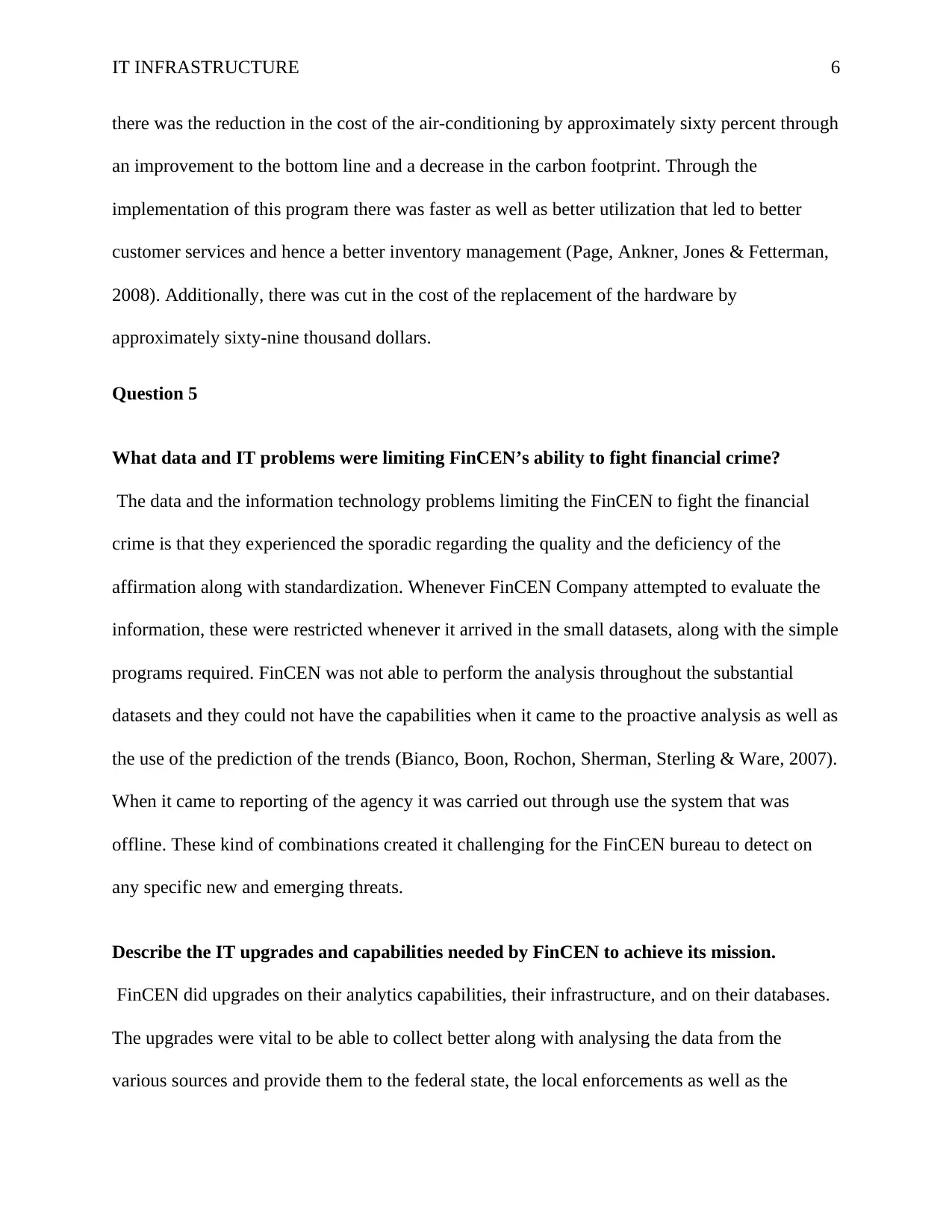
IT INFRASTRUCTURE 6
there was the reduction in the cost of the air-conditioning by approximately sixty percent through
an improvement to the bottom line and a decrease in the carbon footprint. Through the
implementation of this program there was faster as well as better utilization that led to better
customer services and hence a better inventory management (Page, Ankner, Jones & Fetterman,
2008). Additionally, there was cut in the cost of the replacement of the hardware by
approximately sixty-nine thousand dollars.
Question 5
What data and IT problems were limiting FinCEN’s ability to fight financial crime?
The data and the information technology problems limiting the FinCEN to fight the financial
crime is that they experienced the sporadic regarding the quality and the deficiency of the
affirmation along with standardization. Whenever FinCEN Company attempted to evaluate the
information, these were restricted whenever it arrived in the small datasets, along with the simple
programs required. FinCEN was not able to perform the analysis throughout the substantial
datasets and they could not have the capabilities when it came to the proactive analysis as well as
the use of the prediction of the trends (Bianco, Boon, Rochon, Sherman, Sterling & Ware, 2007).
When it came to reporting of the agency it was carried out through use the system that was
offline. These kind of combinations created it challenging for the FinCEN bureau to detect on
any specific new and emerging threats.
Describe the IT upgrades and capabilities needed by FinCEN to achieve its mission.
FinCEN did upgrades on their analytics capabilities, their infrastructure, and on their databases.
The upgrades were vital to be able to collect better along with analysing the data from the
various sources and provide them to the federal state, the local enforcements as well as the
there was the reduction in the cost of the air-conditioning by approximately sixty percent through
an improvement to the bottom line and a decrease in the carbon footprint. Through the
implementation of this program there was faster as well as better utilization that led to better
customer services and hence a better inventory management (Page, Ankner, Jones & Fetterman,
2008). Additionally, there was cut in the cost of the replacement of the hardware by
approximately sixty-nine thousand dollars.
Question 5
What data and IT problems were limiting FinCEN’s ability to fight financial crime?
The data and the information technology problems limiting the FinCEN to fight the financial
crime is that they experienced the sporadic regarding the quality and the deficiency of the
affirmation along with standardization. Whenever FinCEN Company attempted to evaluate the
information, these were restricted whenever it arrived in the small datasets, along with the simple
programs required. FinCEN was not able to perform the analysis throughout the substantial
datasets and they could not have the capabilities when it came to the proactive analysis as well as
the use of the prediction of the trends (Bianco, Boon, Rochon, Sherman, Sterling & Ware, 2007).
When it came to reporting of the agency it was carried out through use the system that was
offline. These kind of combinations created it challenging for the FinCEN bureau to detect on
any specific new and emerging threats.
Describe the IT upgrades and capabilities needed by FinCEN to achieve its mission.
FinCEN did upgrades on their analytics capabilities, their infrastructure, and on their databases.
The upgrades were vital to be able to collect better along with analysing the data from the
various sources and provide them to the federal state, the local enforcements as well as the
⊘ This is a preview!⊘
Do you want full access?
Subscribe today to unlock all pages.

Trusted by 1+ million students worldwide
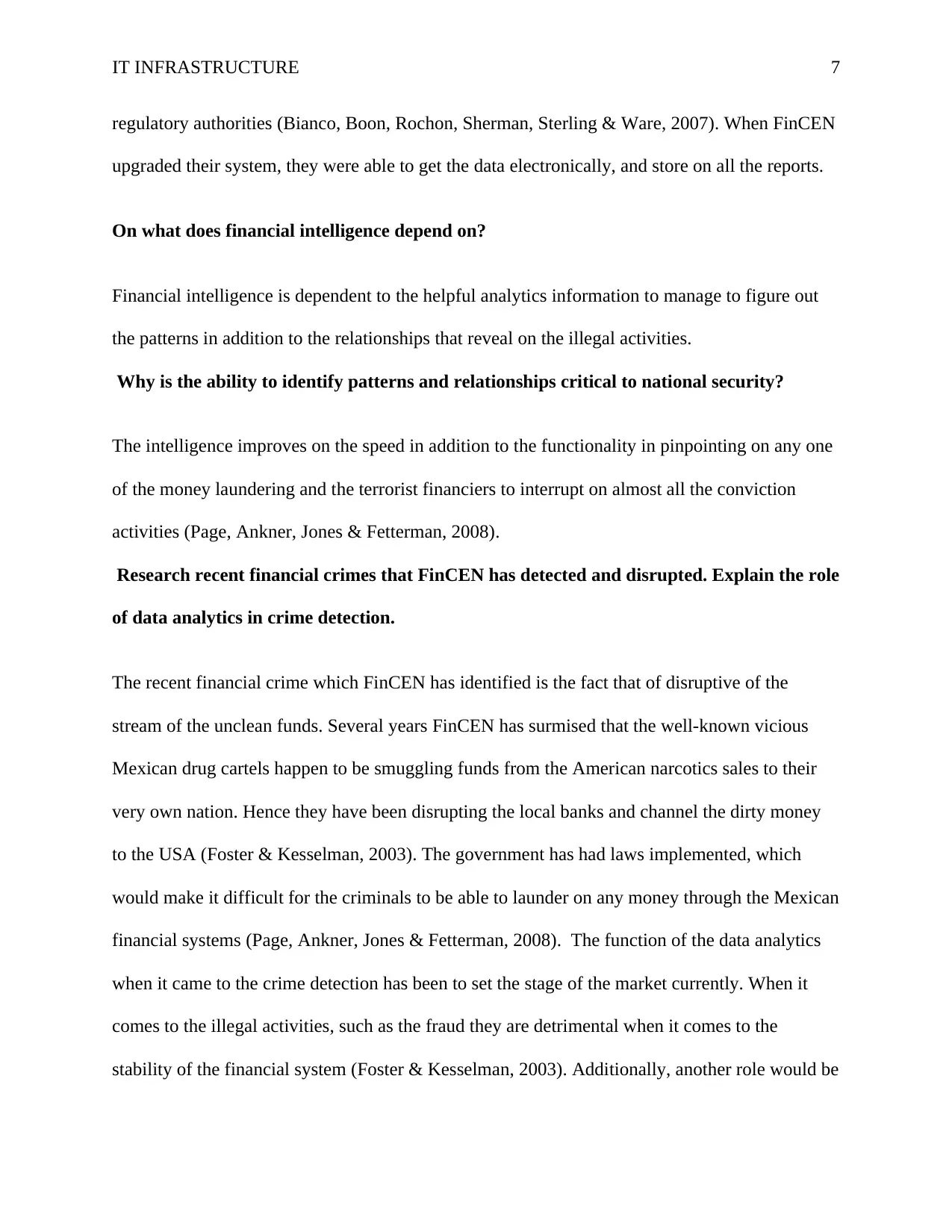
IT INFRASTRUCTURE 7
regulatory authorities (Bianco, Boon, Rochon, Sherman, Sterling & Ware, 2007). When FinCEN
upgraded their system, they were able to get the data electronically, and store on all the reports.
On what does financial intelligence depend on?
Financial intelligence is dependent to the helpful analytics information to manage to figure out
the patterns in addition to the relationships that reveal on the illegal activities.
Why is the ability to identify patterns and relationships critical to national security?
The intelligence improves on the speed in addition to the functionality in pinpointing on any one
of the money laundering and the terrorist financiers to interrupt on almost all the conviction
activities (Page, Ankner, Jones & Fetterman, 2008).
Research recent financial crimes that FinCEN has detected and disrupted. Explain the role
of data analytics in crime detection.
The recent financial crime which FinCEN has identified is the fact that of disruptive of the
stream of the unclean funds. Several years FinCEN has surmised that the well-known vicious
Mexican drug cartels happen to be smuggling funds from the American narcotics sales to their
very own nation. Hence they have been disrupting the local banks and channel the dirty money
to the USA (Foster & Kesselman, 2003). The government has had laws implemented, which
would make it difficult for the criminals to be able to launder on any money through the Mexican
financial systems (Page, Ankner, Jones & Fetterman, 2008). The function of the data analytics
when it came to the crime detection has been to set the stage of the market currently. When it
comes to the illegal activities, such as the fraud they are detrimental when it comes to the
stability of the financial system (Foster & Kesselman, 2003). Additionally, another role would be
regulatory authorities (Bianco, Boon, Rochon, Sherman, Sterling & Ware, 2007). When FinCEN
upgraded their system, they were able to get the data electronically, and store on all the reports.
On what does financial intelligence depend on?
Financial intelligence is dependent to the helpful analytics information to manage to figure out
the patterns in addition to the relationships that reveal on the illegal activities.
Why is the ability to identify patterns and relationships critical to national security?
The intelligence improves on the speed in addition to the functionality in pinpointing on any one
of the money laundering and the terrorist financiers to interrupt on almost all the conviction
activities (Page, Ankner, Jones & Fetterman, 2008).
Research recent financial crimes that FinCEN has detected and disrupted. Explain the role
of data analytics in crime detection.
The recent financial crime which FinCEN has identified is the fact that of disruptive of the
stream of the unclean funds. Several years FinCEN has surmised that the well-known vicious
Mexican drug cartels happen to be smuggling funds from the American narcotics sales to their
very own nation. Hence they have been disrupting the local banks and channel the dirty money
to the USA (Foster & Kesselman, 2003). The government has had laws implemented, which
would make it difficult for the criminals to be able to launder on any money through the Mexican
financial systems (Page, Ankner, Jones & Fetterman, 2008). The function of the data analytics
when it came to the crime detection has been to set the stage of the market currently. When it
comes to the illegal activities, such as the fraud they are detrimental when it comes to the
stability of the financial system (Foster & Kesselman, 2003). Additionally, another role would be
Paraphrase This Document
Need a fresh take? Get an instant paraphrase of this document with our AI Paraphraser

IT INFRASTRUCTURE 8
to incorporate the investigation units that maintain the information for the detection of the fraud
and have the integration of the systems.
to incorporate the investigation units that maintain the information for the detection of the fraud
and have the integration of the systems.
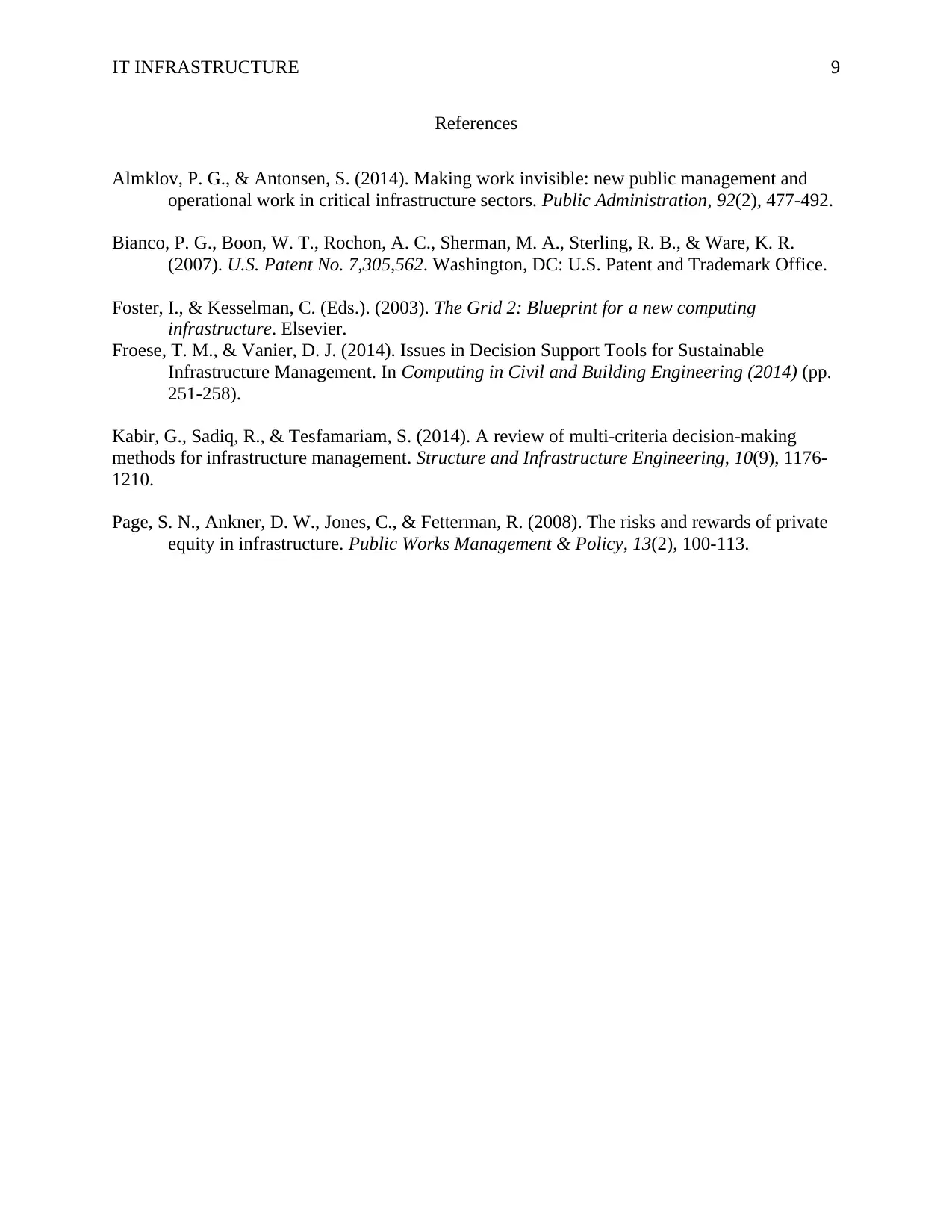
IT INFRASTRUCTURE 9
References
Almklov, P. G., & Antonsen, S. (2014). Making work invisible: new public management and
operational work in critical infrastructure sectors. Public Administration, 92(2), 477-492.
Bianco, P. G., Boon, W. T., Rochon, A. C., Sherman, M. A., Sterling, R. B., & Ware, K. R.
(2007). U.S. Patent No. 7,305,562. Washington, DC: U.S. Patent and Trademark Office.
Foster, I., & Kesselman, C. (Eds.). (2003). The Grid 2: Blueprint for a new computing
infrastructure. Elsevier.
Froese, T. M., & Vanier, D. J. (2014). Issues in Decision Support Tools for Sustainable
Infrastructure Management. In Computing in Civil and Building Engineering (2014) (pp.
251-258).
Kabir, G., Sadiq, R., & Tesfamariam, S. (2014). A review of multi-criteria decision-making
methods for infrastructure management. Structure and Infrastructure Engineering, 10(9), 1176-
1210.
Page, S. N., Ankner, D. W., Jones, C., & Fetterman, R. (2008). The risks and rewards of private
equity in infrastructure. Public Works Management & Policy, 13(2), 100-113.
References
Almklov, P. G., & Antonsen, S. (2014). Making work invisible: new public management and
operational work in critical infrastructure sectors. Public Administration, 92(2), 477-492.
Bianco, P. G., Boon, W. T., Rochon, A. C., Sherman, M. A., Sterling, R. B., & Ware, K. R.
(2007). U.S. Patent No. 7,305,562. Washington, DC: U.S. Patent and Trademark Office.
Foster, I., & Kesselman, C. (Eds.). (2003). The Grid 2: Blueprint for a new computing
infrastructure. Elsevier.
Froese, T. M., & Vanier, D. J. (2014). Issues in Decision Support Tools for Sustainable
Infrastructure Management. In Computing in Civil and Building Engineering (2014) (pp.
251-258).
Kabir, G., Sadiq, R., & Tesfamariam, S. (2014). A review of multi-criteria decision-making
methods for infrastructure management. Structure and Infrastructure Engineering, 10(9), 1176-
1210.
Page, S. N., Ankner, D. W., Jones, C., & Fetterman, R. (2008). The risks and rewards of private
equity in infrastructure. Public Works Management & Policy, 13(2), 100-113.
⊘ This is a preview!⊘
Do you want full access?
Subscribe today to unlock all pages.

Trusted by 1+ million students worldwide
1 out of 9
Related Documents
Your All-in-One AI-Powered Toolkit for Academic Success.
+13062052269
info@desklib.com
Available 24*7 on WhatsApp / Email
![[object Object]](/_next/static/media/star-bottom.7253800d.svg)
Unlock your academic potential
Copyright © 2020–2025 A2Z Services. All Rights Reserved. Developed and managed by ZUCOL.





